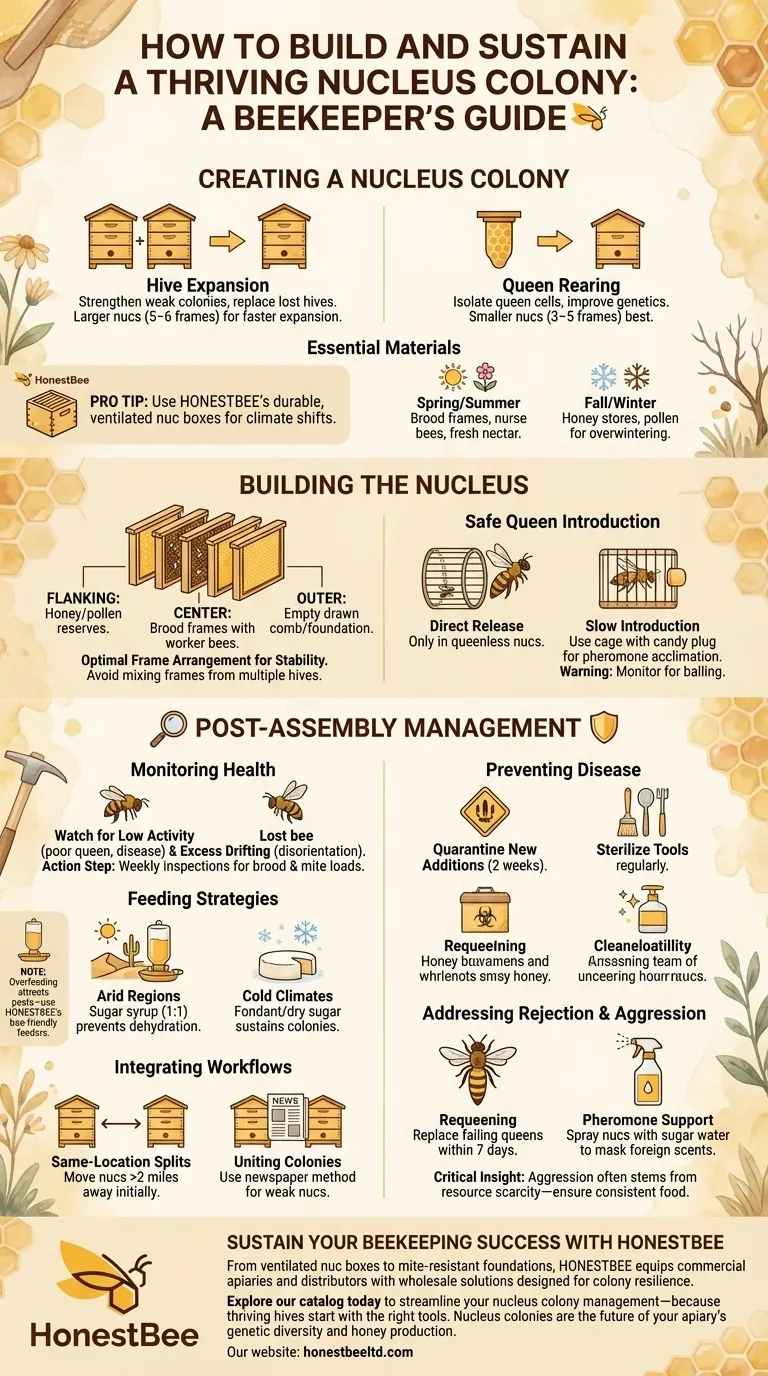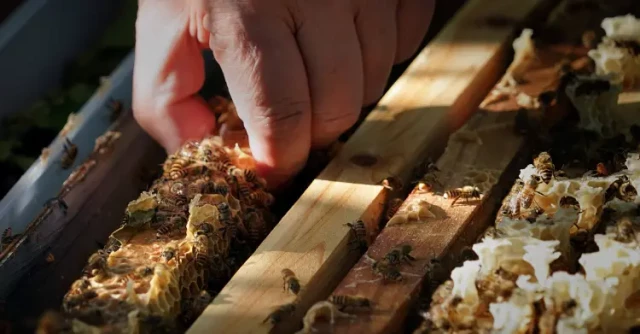Whether you're expanding your apiary or rearing queens, nucleus colonies ("nucs") are the backbone of productive beekeeping. This guide walks you through every phase—from assembly to long-term management—while addressing seasonal challenges and risks.
Creating a Nucleus Colony
Defining Goals: Hive Expansion vs. Queen Rearing
Nucleus colonies serve two primary purposes:
- Hive Expansion: Strengthen weak colonies or replace lost hives by splitting resources.
- Queen Rearing: Isolate queen cells to control genetics and improve hive productivity.
Key Consideration: Smaller nucs (3–5 frames) work best for queen rearing, while larger setups (5–6 frames) support faster hive expansion.
Essential Materials: Seasonal Variations in Resource Selection
Tailor your nucleus setup to local conditions:
- Spring/Summer: Prioritize brood frames with nurse bees and fresh nectar.
- Fall/Winter: Include honey stores and pollen for overwintering.
Pro Tip: Use HONESTBEE’s durable nuc boxes with ventilation adjustments to accommodate climate shifts.
Building the Nucleus
Optimal Frame Arrangement for Colony Stability
A balanced frame layout ensures colony cohesion:
- Center: Brood frames (2–3) with adhering worker bees.
- Flanking Frames: Honey/pollen reserves for immediate sustenance.
- Outer Frames: Empty drawn comb or foundation for expansion.
Avoid: Mixing frames from multiple hives, which can trigger aggression.
Safe Queen Introduction Techniques
Queen acceptance hinges on gradual integration:
- Direct Release: Only in queenless nucs with no competing cells.
- Slow Introduction: Use a cage with candy plug for pheromone acclimation.
Warning: Monitor for balling (worker bees attacking the queen) in the first 48 hours.
Post-Assembly Management
Monitoring Health: Detecting Early Stress Indicators
Watch for:
- Low Activity: May indicate poor queen performance or disease.
- Excess Drifting: Bees returning to parent hives signal disorientation.
Action Step: Conduct weekly inspections for brood patterns and mite loads.
Feeding Strategies for Different Climates
- Arid Regions: Sugar syrup (1:1 ratio) prevents dehydration.
- Cold Climates: Fondant or dry sugar sustains colonies during winter.
Note: Overfeeding can attract pests—use HONESTBEE’s bee-friendly feeders with reduced robbing risk.
Integrating Nucleus Colonies into Existing Apiary Workflows
- Same-Location Splits: Move nucs >2 miles away initially to prevent drift.
- Uniting Colonies: Use newspaper method to merge weak nucs with stronger hives.
Risk Mitigation
Preventing Disease Transmission in Compact Colonies
Nucs are vulnerable due to limited bee populations:
- Quarantine New Additions: Isolate for 2 weeks before introducing frames.
- Sterilize Tools: Regularly clean hive tools and gloves between inspections.
Addressing Queen Rejection and Colony Aggression
- Requeening: Replace failing queens within 7 days to avoid worker egg-laying.
- Pheromone Support: Spray nucs with sugar water to mask foreign queen scents.
Critical Insight: Aggression often stems from resource scarcity—ensure consistent food access.
Sustain Your Beekeeping Success with HONESTBEE
From ventilated nuc boxes to mite-resistant foundations, HONESTBEE equips commercial apiaries and distributors with wholesale solutions designed for colony resilience. Explore our catalog today to streamline your nucleus colony management—because thriving hives start with the right tools.
Final Thought: Nucleus colonies aren’t just temporary setups; they’re the future of your apiary’s genetic diversity and honey production. With careful planning and the right resources, you’ll turn compact colonies into long-term assets.
Visual Guide

Related Products
- 5 Frame Wooden Nuc Box for Beekeeping
- Twin Queen Styrofoam Honey Bee Nucs Mating and Breeding Box
- Automatic Heat Preservation 6 Frame Pro Nuc Box for Honey Bee Queen Mating
- Styrofoam Mini Mating Nuc Box with Frames Feeder Styrofoam Bee Hives 3 Frame Nuc Box
- Plastic Transporting Bee Packages and Nuc Boxes for Beekeeping
Related Articles
- How Smaller Nuc Box Frames Improve Brood Health Through Thermal Regulation
- When Shallow Hive Boxes Outperform Deep Supers: Niche Applications in Modern Beekeeping
- The Essential Guide to Beehive Boxes: Maximizing Colony Health and Productivity
- Plastic Bee Hives: A Smart Investment for Modern Beekeepers
- How Medium Boxes Elevate Beekeeping Efficiency: Ergonomics, Hive Health & Cost Savings




















